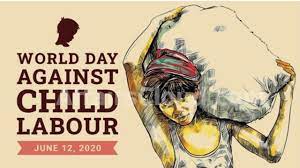
World Day Against Child Labor
World Day Against Child Labor , Daily Current Affairs , RACE IAS : Best IAS Coaching in Lucknow
Foreword:
- World Day Against Child Labor is observed every year on 12 June across the globe, which aims to serve as a catalyst for the growing worldwide movement against child labour.
- Emphasizing the link between social justice and child labour, the slogan for the World Day this year is: 'Social justice for all, end child labour'.
About this day:
- This day was started by the International Labor Organization in the year 2002 with the aim of ending child labour.
- Each year this world day brings together governments, employers, labor organizations, civil society as well as millions of people around the world to highlight and help the plight of child labour.
Issues related to child labor in India:
- The situation of child labor in India is pathetic, around 160 million children were subjected to child labor in early 2020 and India contributes a large number of them. This implies that almost one-third of India's population is under the age of 18, which suggests that the risk is high.
- India ranks second in terms of child labor. The condition of the children here is pathetic. This is a serious and widespread problem as many children below the age of 14 are working in hazardous factories.
- According to the 2011 census, the number of child laborers in India was 10.1 million, of which 5.6 million were boys and 4.5 million were girls.
- Indian children are facing major issues like gender inequality, child marriage, malnutrition, child trafficking etc. But the main problem is the lack of knowledge of the cause and non-availability of legal remedies.
- Currently, around 218 million children work worldwide, many of them full-time.
Constitutional and legal provisions against child labor:
- According to Article 23 of the Indian Constitution, any form of forced labor is prohibited.
- According to Article 24, a child below the age of 14 years cannot be employed to do any hazardous work.
- According to Article 39 "the health and strength of workers, men and women, and the tender age of children are not abused".
- The Child Labor Act (Prohibition and Regulation) 1986, enacted based on the recommendations of the Gurupadaswamy Committee, prohibits children below the age of 14 from working in hazardous industries and processes.
- Policy interventions such as MGNREGA 2005, Right to Education Act, 2009 and Mid Day Meal Scheme have led to guaranteed wage employment (for unskilled workers) for rural households as well as children staying in schools.
- Also with the ratification of Convention No. 138 and 182 of the International Labor Organization in the year 2017, the Government of India has demonstrated its commitment to the elimination of child labour, including children engaged in hazardous occupations.
Major Issues related to Child labor:
- Cause-effect relationship: Child labor and exploitation are the result of many factors, including poverty, social norms condoning them, lack of decent work opportunities for adults and adolescents, migration and emergencies. These factors are not only causes of social inequalities but also result of discrimination.
- Threat to the national economy: Due to the continuation of child labour, exploitation and lack of access to schools, their physical and mental health is deteriorating. This is proving negative for the national economy.
- Child labor in the unorganized sector: Child labor in the country is completely banned under the legal process,despite this, child laborers across India are working in various unorganized industries such as brick kilns, carpet weaving, garment manufacturing, agriculture, fisheries etc.
- Child Trafficking: Child trafficking is linked to child labor and always results in child abuse.
- Trafficked children are forced into illegal acts such as prostitution or are illegally adopted; They provide cheap or unpaid labor, are forced to work as domestic servants or beggars, and may be recruited into armed groups.
Conclusions:
- Children are made to study in schools, not to work in workplaces. Child labor deprives children of their right to go to school and makes poverty generational. Child labor serves as a major barrier to education, affecting both attendance and performance in school.
- Despite the decline in the rate of child labor over the years, children are still being used as disguised child labor in tasks such as domestic help.
- Child labor may not appear to be dangerous in the immediate term but it can produce long term and disastrous consequences for their education, their skill acquisition.
- Therefore their future prospects need to be controlled child labor to remove the vicious circle of poverty, incomplete education and poor quality jobs.
------------------------------------------
Mains Exam Question
Elucidate the issues related to child labor and suggest solutions for its control.